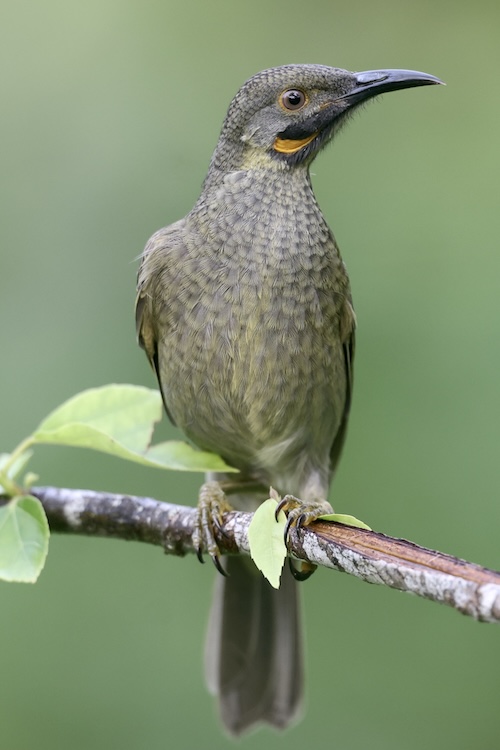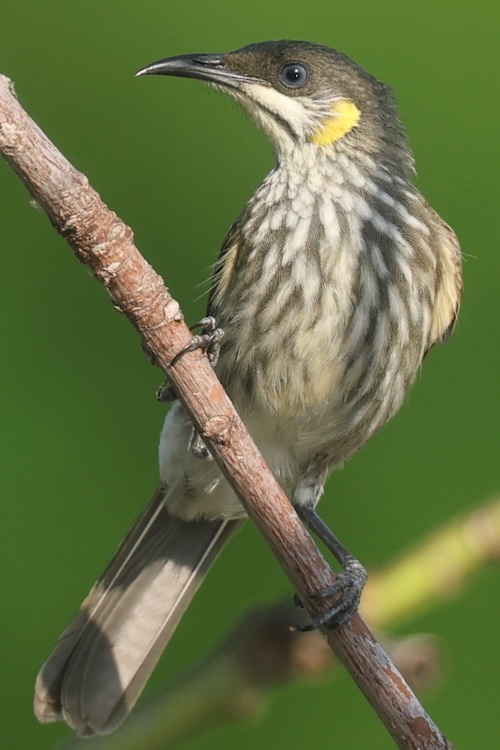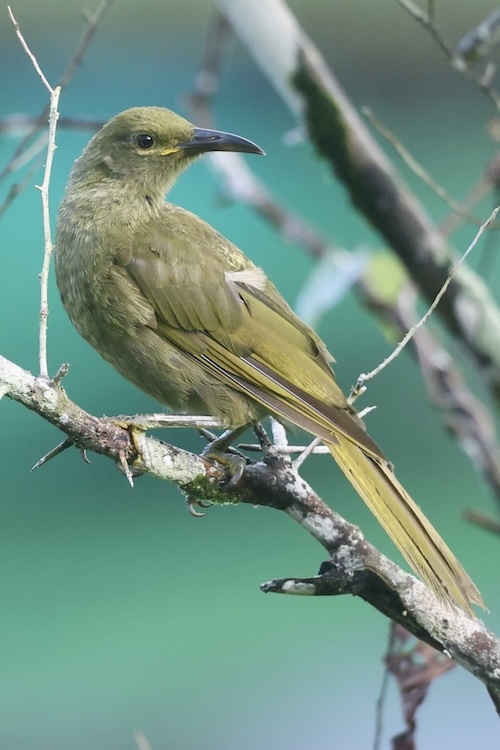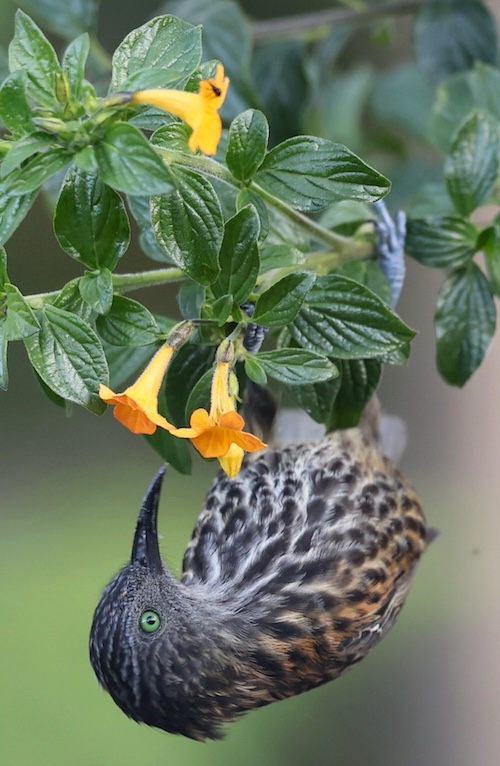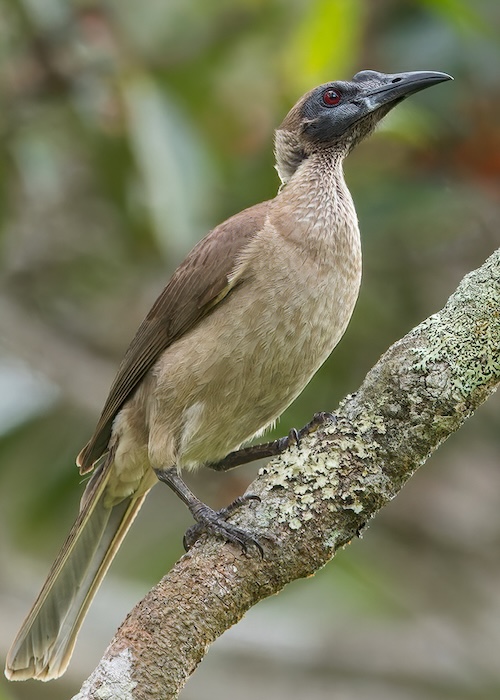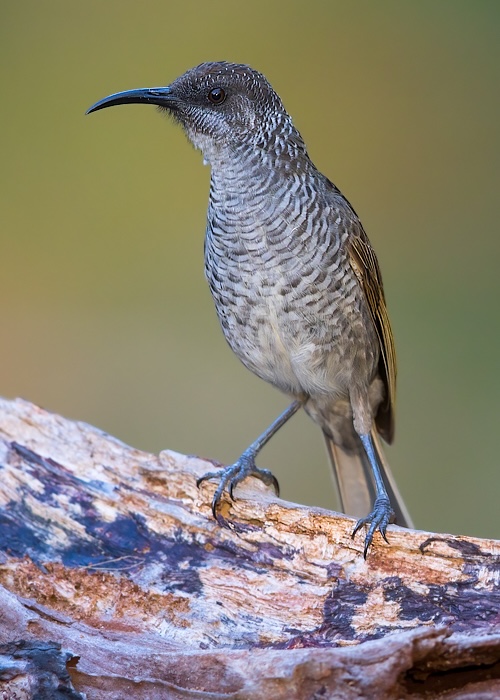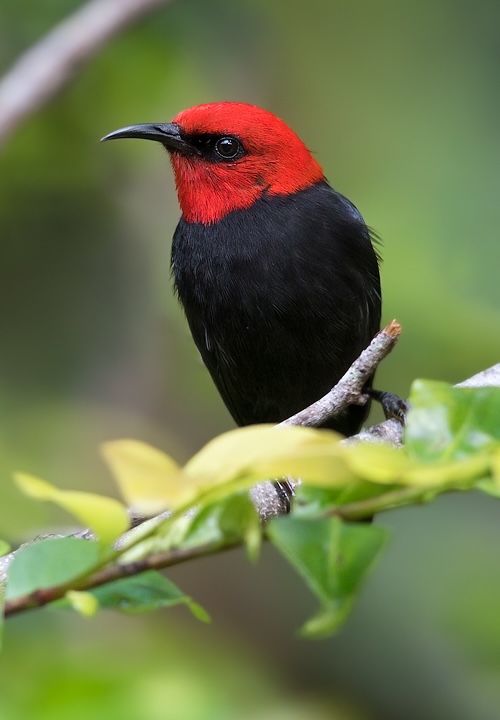Meliphagidae – Honeyeaters

The Meliphagidae (Honeyeaters, Friarbirds, Australian Chats, Miners, Myzomelas, Wattlebirds and allies) are a large and diverse family of small to medium-sized birds most common in Australia and New Guinea, but also found in New Zealand, the Pacific islands as far east as Samoa and Tonga, and the islands to the north and west of New Guinea known as Wallacea. Bali, on the other side of the Wallace Line, has a single species.
In total there are one hundred & ninety-three species in fifty-one genera, roughly half of them native to Australia, many of the remainder occupying New Guinea. With their closest relatives, the Maluridae (Australian fairy-wrens), Pardalotidae (pardalotes), and Acanthizidae (thornbills, Australian warblers, scrubwrens, etc.) they comprise the superfamily Meliphagoidea and originated early in the evolutionary history of the oscine passerine radiation.
|
|
|
| Fiji Wattled Honeyeater Foulehaio taviunensis |
Streak-breasted Honeyeater Meliphaga reticulata |
|
|
|
| Giant Honeyeater Gymnomyza brunneirostris |
Rufous-backed Honeyeater Ptiloprora guisei |
|
The four photos above courtesy of Nick Ludovic Green ©Bird-Photo-Tours ASIA |
|
Although honeyeaters look and behave very much like other nectar-feeding passerines around the world (such as the sunbirds and flowerpeckers), they are unrelated, and the similarities are the consequence of convergent evolution.
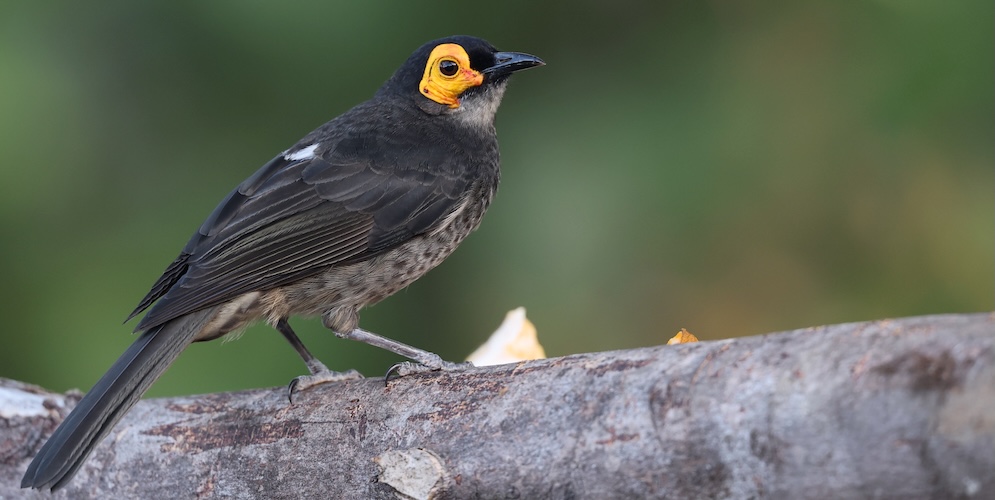
Common Smoky Honeyeater Melipotes fumigatus – Nick Ludovioc Green Bird-Photo-Tours ASIA
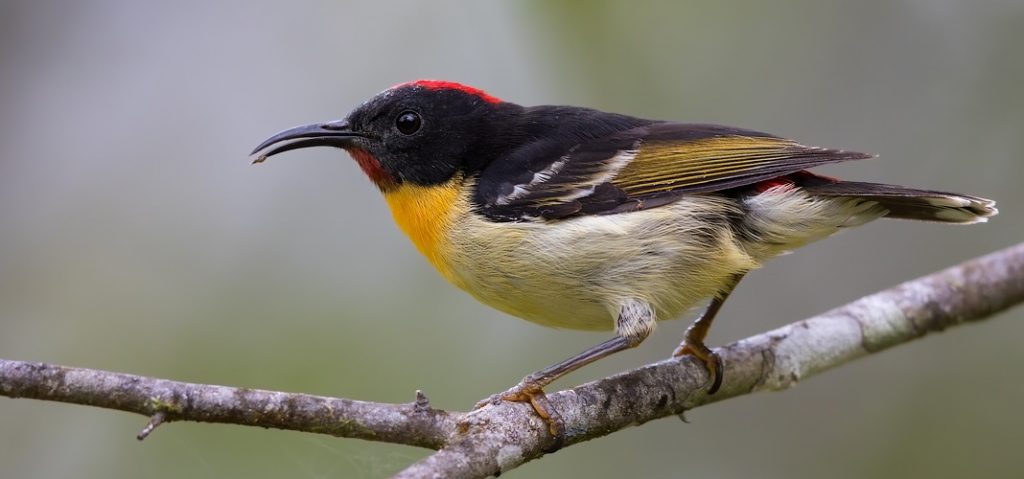
Sulphur-breasted Myzomela Myzomela jugularis – ©Dubi Shapiro
Meliphagoidea is a superfamily of passerine birds. They contain a vast diversity of small to mid-sized passerines widespread in the Austro-pacific region. The Australian Continent has the largest richness in genera and species including the Meliphagidae.
The extent of the evolutionary partnership between honeyeaters and Australasian flowering plants is unknown, but probably substantial. A great many Australian plants are fertilised by honeyeaters, particularly the Proteaceae, Myrtaceae, and Epacridaceae. It is known that the honeyeaters are important in New Zealand as well, and we assume that it is the same in other areas.
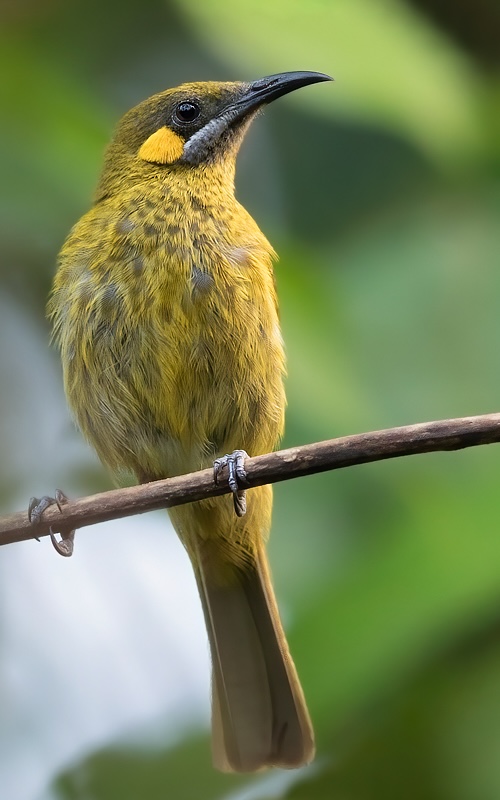 |
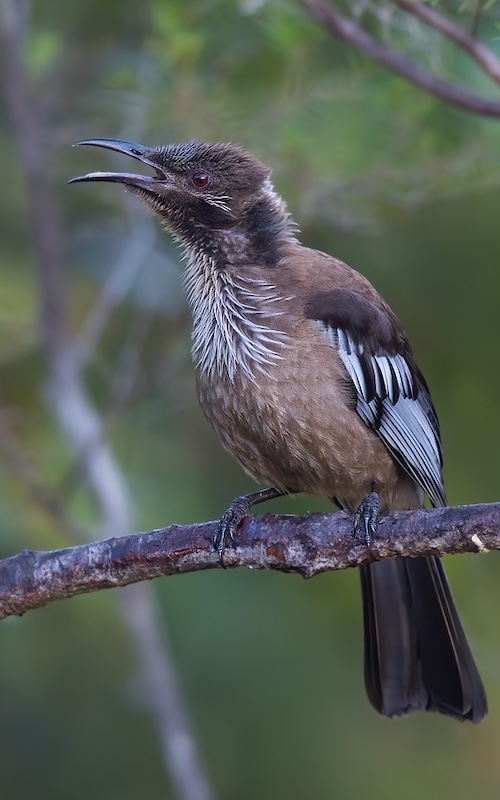 |
| Flame-eared Honeyeater Lichmera flavicans | New Caledonian Friarbird Philemon diemenensis |
| Both the above photos courtesy of ©Dubi Shapiro | |
Honeyeaters can be either nectarivorous, insectivorous, frugivorous, or a combination of nectar and insect-eating. Unlike the hummingbirds of America, honeyeaters do not have extensive adaptations for hovering flight, though smaller members of the family do hover hummingbird-style to collect nectar from time to time. In general, honeyeaters prefer to flit quickly from perch to perch in the outer foliage, stretching up or sideways or hanging upside down at need. Many genera have a highly developed brush-tipped tongue, frayed and fringed with bristles which soak up liquids readily. The tongue is flicked rapidly and repeatedly into a flower, the upper mandible then compressing any liquid out when the bill is closed.
|
|
|
|
Helmeted Friarbird Philemon buceroides |
Barred Honeyeater Gliciphila undulata |
| Both the above photos courtesy of ©Dubi Shapiro | |
Honeyeaters can be either nectarivorous, insectivorous, frugivorous, or a combination of nectar and insect-eating. Unlike the hummingbirds of America, honeyeaters do not have extensive adaptations for hovering flight, though smaller members of the family do hover hummingbird-style to collect nectar from time to time. In general, honeyeaters prefer to flit quickly from perch to perch in the outer foliage, stretching up or sideways or hanging upside down at need. Many genera have a highly developed brush-tipped tongue, frayed and fringed with bristles which soak up liquids readily. The tongue is flicked rapidly and repeatedly into a flower, the upper mandible then compressing any liquid out when the bill is closed.
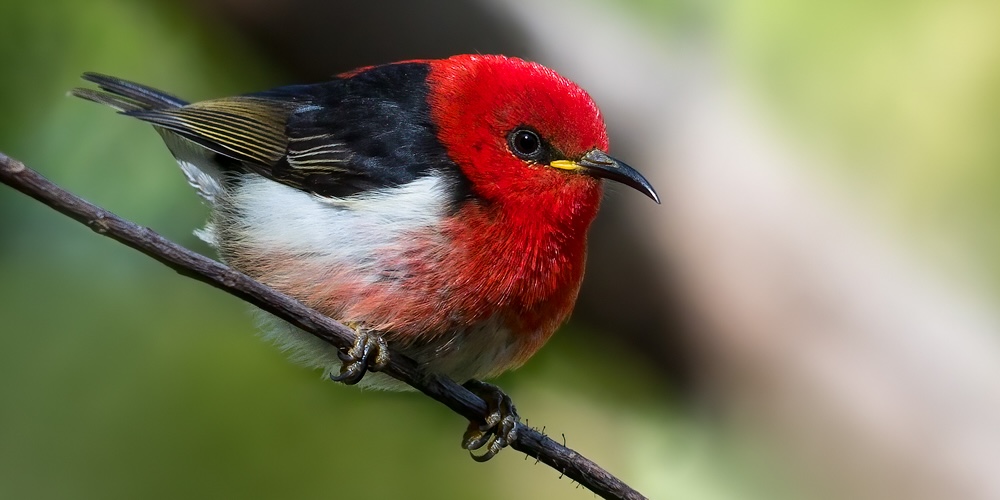
New Caledonian Myzomela Myzomela caledonica – ©Dubi Shapiro
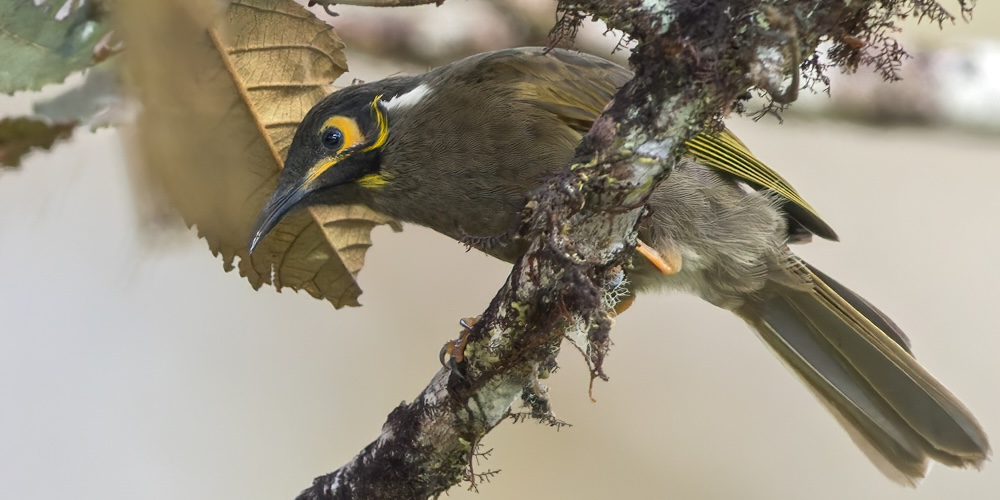
Black-throated Honeyeater Caligavis subfrenata – ©Dubi Shapiro
In addition to nectar, all or nearly all honeyeaters take insects and other small arthropods, usually by hawking, sometimes by gleaning. A few of the larger species, notably the White-eared Honeyeater, and the Strong-billed Honeyeater of Tasmania, probe under bark for insects and other morsels. Many species supplement their diets with a little fruit, and a small number eat considerable amounts of fruit, particularly in tropical rainforests and, oddly, in semi-arid scrubland.
The Painted Honeyeater is a mistletoe specialist. Most, however, exist on a diet of nectar supplemented by varying quantities of insects. In general, the honeyeaters with long, fine bills are more nectarivorous, the shorter-billed species less so, but even specialised nectar eaters like the spinebills take extra insects to add protein to their diet when breeding. Most have bills that are at least slightly decurved, with ornamentation of brilliantly coloured skin or feather tufts very common on the head and upper breast.
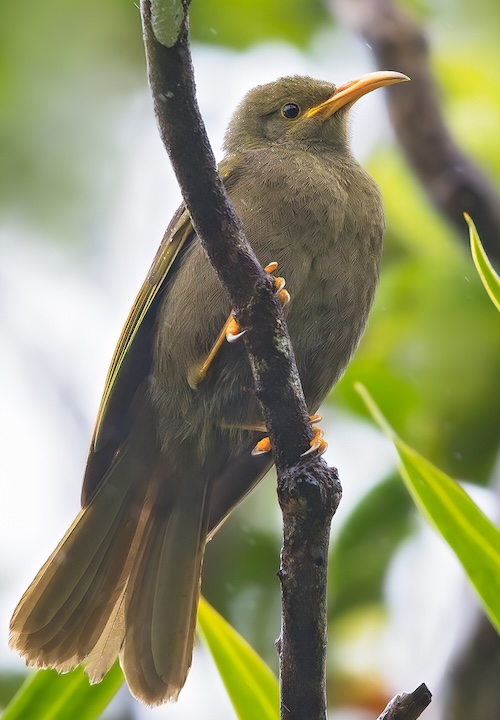 |
|
|
Yellow-billed Honeyeater Gymnomyza viridis |
Cardinal Myzomela Myzomela cardinalis |
| Both the above photos courtesy of ©Dubi Shapiro | |
The movements of honeyeaters are poorly understood. Most are at least partially mobile, but many movements seem to be local, possibly between favourite haunts as the conditions change. Fluctuations in local abundance are common, but the small number of definitely migratory honeyeater species aside, the reasons are yet to be discovered. Many follow the flowering of favourite food plants. Arid zone species appear to travel further and less predictably than those of the more fertile areas. It seems probable that no single explanation will emerge.
They generally form monogamous pairs, share parental care, build deep cup nests from vegetation, suspended in tree forks, lay one to four eggs, and some, such as the miners have helpers at the nest, with variations like cooperative breeding in some species; breeding seasons are often linked to resource availability, with some species nesting year-round in favourable conditions, and incubation/nestling periods typically lasting around two to four weeks in total, though specifics vary greatly by species and region.
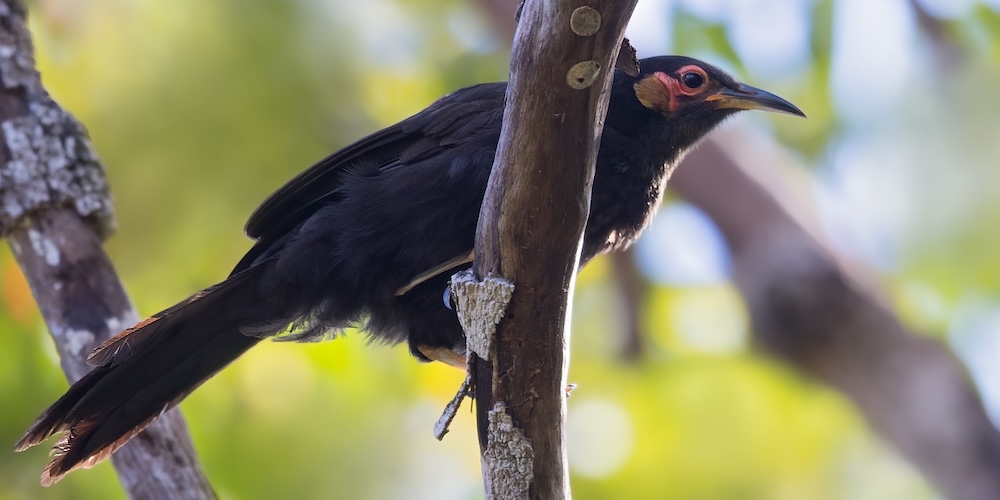
Crow Honeyeater Gymnomyza aubryana – ©Dubi Shapiro
As noted, there are variations. For example, Red Wattlebirds and Noisy Friarbirds have long breeding seasons with multiple attempts. Their clutches are two to three eggs and incubation and nesting can last around 16 days. Black-chinned Honeyeaters are communal breeders and have helpers. They raise multiple broods and are often parasitised by cuckoos. Brown Honeyeaters are solitary nesters. They breed year-round in the right conditions and produce small clutches, usually two eggs which the female incubates alone although both parents feed the Young.
-
Number of bird species: 193
(As at December 2025)
According to the recently (2025) amalgamated AviList, there are one hundred and ninety-three species of honeyeater, miner, friarbird, myzomela and allies in fifty-one genera in the family. They are:
Dark-eared Myza Myza celebensis
White-eared Myza Myza sarasinorum
Western Spinebill Acanthorhynchus superciliosus
Eastern Spinebill Acanthorhynchus tenuirostris
Green-backed Honeyeater Glycichaera fallax
Sooty Honeyeater Melidectes fuscus
Short-bearded Honeyeater Melidectes nouhuysi
Long-bearded Honeyeater Melidectes princeps
Leaden Honeyeater Ptiloprora plumbea
Yellowish-streaked Honeyeater Ptiloprora meekiana
Rufous-sided Honeyeater Ptiloprora erythropleura
Mayr’s Honeyeater Ptiloprora mayri
Rufous-backed Honeyeater Ptiloprora guisei
Grey-streaked Honeyeater Ptiloprora perstriata
Gibberbird Ashbyia lovensis
Yellow Chat Epthianura crocea
Crimson Chat Epthianura tricolor
Orange Chat Epthianura aurifrons
White-fronted Chat Epthianura albifrons
Bougainville Honeyeater Stresemannia bougainvillei
Bar-breasted Honeyeater Ramsayornis fasciatus
Brown-backed Honeyeater Ramsayornis modestus
Rufous-banded Honeyeater Conopophila albogularis
Rufous-throated Honeyeater Conopophila rufogularis
Grey Honeyeater Conopophila whitei
Long-billed Honeyeater Melilestes megarhynchus
Tawny Straightbill Timeliopsis griseigula
Olive Straightbill Timeliopsis fulvigula
MacGregor’s Honeyeater Macgregoria pulchra
Arfak Honeyeater Melipotes gymnops
Common Smoky Honeyeater Melipotes fumigatus
Wattled Smoky Honeyeater Melipotes carolae
Spangled Honeyeater Melipotes ater
Barred Honeyeater Gliciphila undulata
Tawny-crowned Honeyeater Gliciphila melanops
White-bellied Honeyeater Gliciphila notabilis
Tui Prosthemadera novaeseelandiae
Chatham Bellbird Anthornis melanocephala
New Zealand Bellbird Anthornis melanura
Pied Honeyeater Certhionyx variegatus
Plain Honeyeater Pycnopygius ixoides
Marbled Honeyeater Pycnopygius cinereus
Streak-headed Honeyeater Pycnopygius stictocephalus
Black Honeyeater Sugomel nigrum
White-streaked Friarbird Melitograis gilolensis
Gilliard’s Honeyeater Vosea whitemanensis
Drab Myzomela Myzomela blasii
White-chinned Myzomela Myzomela albigula
Ruby-throated Myzomela Myzomela eques
Ashy Myzomela Myzomela cineracea
Moluccan Myzomela Myzomela simplex
Red-tinged Myzomela Myzomela rubrotincta
Biak Myzomela Myzomela rubrobrunnea
Dusky Myzomela Myzomela obscura
Red Myzomela Myzomela cruentata
Redish Myzomela Myzomela erythrina
Papuan Black Myzomela Myzomela nigrita
New Ireland Myzomela Myzomela pulchella
Alor Myzomela Myzomela prawiradilagae
Crimson-hooded Myzomela Myzomela kuehni
Red-headed Myzomela Myzomela erythrocephala
Sumba Myzomela Myzomela dammermani
Rote Myzomela Myzomela irianawidodoae
Mountain Myzomela Myzomela adolphinae
Sulawesi Myzomela Myzomela chloroptera
Bacan Myzomela Myzomela batjanensis
Taliabu Myzomela Myzomela wahe
Wakolo Myzomela Myzomela wakoloensis
Banda Myzomela Myzomela boiei
New Caledonian Myzomela Myzomela caledonica
Scarlet Myzomela Myzomela sanguinolenta
Micronesian Myzomela Myzomela rubratra
Cardinal Myzomela Myzomela cardinalis
Samoan Myzomela Myzomela nigriventris
Rotuma Myzomela Myzomela chermesina
Sclater’s Myzomela Myzomela sclateri
Bismarck Black Myzomela Myzomela pammelaena
Red-capped Myzomela Myzomela lafargei
Crimson-rumped Myzomela Myzomela eichhorni
Red-vested Myzomela Myzomela malaitae
Black-headed Myzomela Myzomela melanocephala
Sooty Myzomela Myzomela tristrami
Sulphur-breasted Myzomela Myzomela jugularis
Black-bellied Myzomela Myzomela erythromelas
Black-breasted Myzomela Myzomela vulnerata
Red-collared Myzomela Myzomela rosenbergii
Long-billed Myzomela Myzomela longirostris
Yellow-billed Honeyeater Gymnomyza viridis
Giant Honeyeater Gymnomyza brunneirostris
Mao Gymnomyza samoensis
Crow Honeyeater Gymnomyza aubryana
Striped Honeyeater Plectorhyncha lanceolata
Painted Honeyeater Grantiella picta
Tawny-breasted Honeyeater Xanthotis flaviventer
Spotted Honeyeater Xanthotis polygrammus
Macleay’s Honeyeater Xanthotis macleayanus
Little Friarbird Philemon citreogularis
Meyer’s Friarbird Philemon meyeri
Timor Friarbird Philemon inornatus
Grey Friarbird Philemon kisserensis
Brass’s Friarbird Philemon brassi
Dusky Friarbird Philemon fuscicapillus
Black-faced Friarbird Philemon moluccensis
Tanimbar Friarbird Philemon plumigenis
Seram Friarbird Philemon subcorniculatus
New Ireland Friarbird Philemon eichhorni
Helmeted Friarbird Philemon buceroides
Manus Friarbird Philemon albitorques
New Britain Friarbird Philemon cockerelli
Silver-crowned Friarbird Philemon argenticeps
Noisy Friarbird Philemon corniculatus
New Caledonian Friarbird Philemon diemenensis
Makira Honeyeater Meliarchus sclateri
Guadalcanal Honeyeater Guadalcanaria inexpectata
Kadavu Honeyeater Meliphacator provocator
Kikau Foulehaio procerior
Polynesian Wattled Honeyeater Foulehaio carunculatus
Fiji Wattled Honeyeater Foulehaio taviunensis
White-streaked Honeyeater Trichodere cockerelli
Crescent Honeyeater Phylidonyris pyrrhopterus
New Holland Honeyeater Phylidonyris novaehollandiae
White-cheeked Honeyeater Phylidonyris niger
Banded Honeyeater Cissomela pectoralis
Scaly-crowned Honeyeater Lichmera lombokia
Olive Honeyeater Lichmera argentauris
Brown Honeyeater Lichmera indistincta
Grey-eared Honeyeater Lichmera incana
Scaly-breasted Honeyeater Lichmera squamata
Silver-eared Honeyeater Lichmera alboauricularis
Buru Honeyeater Lichmera deningeri
Seram Honeyeater Lichmera monticola
Flame-eared Honeyeater Lichmera flavicans
Black-necklaced Honeyeater Lichmera notabilis
Yellow-throated Honeyeater Nesoptilotis flavicollis
White-eared Honeyeater Nesoptilotis leucotis
Blue-faced Honeyeater Entomyzon cyanotis
White-throated Honeyeater Melithreptus albogularis
Gilbert’s Honeyeater Melithreptus chloropsis
White-naped Honeyeater Melithreptus lunatus
Black-headed Honeyeater Melithreptus affinis
Brown-headed Honeyeater Melithreptus brevirostris
Black-chinned Honeyeater Melithreptus gularis
Strong-billed Honeyeater Melithreptus validirostris
White-gaped Honeyeater Stomiopera unicolor
Yellow Honeyeater Stomiopera flava
Puff-backed Honeyeater Meliphaga aruensis
Yellow-spotted Honeyeater Meliphaga notata
Lewin’s Honeyeater Meliphaga lewinii
Streak-breasted Honeyeater Meliphaga reticulata
Kimberley Honeyeater Meliphaga fordiana
White-lined Honeyeater Meliphaga albilineata
Orange-cheeked Honeyeater Meliphaga chrysogenys
Forest Honeyeater Meliphaga montana
Mottle-breasted Honeyeater Meliphaga mimikae
Yellow-gaped Honeyeater Meliphaga flavirictus
Mountain Honeyeater Meliphaga orientalis
Scrub Honeyeater Meliphaga albonotata
Mimic Honeyeater Meliphaga analoga
Tagula Honeyeater Meliphaga vicina
Graceful Honeyeater Meliphaga gracilis
Cryptic Honeyeater Meliphaga imitatrix
Elegant Honeyeater Meliphaga cinereifrons
White-fronted Honeyeater Purnella albifrons
Purple-gaped Honeyeater Lichenostomus cratitius
Yellow-tufted Honeyeater Lichenostomus melanops
Varied Honeyeater Gavicalis versicolor
Mangrove Honeyeater Gavicalis fasciogularis
Singing Honeyeater Gavicalis virescens
Yellow-plumed Honeyeater Ptilotula ornata
White-plumed Honeyeater Ptilotula penicillata
Yellow-tinted Honeyeater Ptilotula flavescens
Fuscous Honeyeater Ptilotula fusca
Grey-headed Honeyeater Ptilotula keartlandi
Grey-fronted Honeyeater Ptilotula plumula
Yellow-faced Honeyeater Caligavis chrysops
Black-throated Honeyeater Caligavis subfrenata
Obscure Honeyeater Caligavis obscura
Spiny-cheeked Honeyeater Acanthagenys rufogularis
Little Wattlebird Anthochaera chrysoptera
Western Wattlebird Anthochaera lunulata
Regent Honeyeater Anthochaera phrygia
Yellow Wattlebird Anthochaera paradoxa
Bridled Honeyeater Bolemoreus frenatus
Eungella Honeyeater Bolemoreus hindwoodi
Bell Miner Manorina melanophrys
Noisy Miner Manorina melanocephala
Yellow-throated Miner Manorina flavigula
Black-eared Miner Manorina melanotis
Ornate Melidectes Melidectes torquatus
Cinnamon-browed Melidectes Melidectes ochromelas
Vogelkop Melidectes Melidectes leucostephes
Huon Melidectes Melidectes foersteri
Belford’s Melidectes Melidectes belfordi
-
Regent Honeyeater Project
WebsiteWorking with landholders to protect and restore our local environment
-
Meliphagidae
Family AccountAlthough a few species of this rich group have dispersed north and east into the islands of the Pacific, the vast majority live in Australo-Papua itself, and none have crossed Wallace’s line into Asia. -
Meliphagidae
Family AccountThe honeyeaters are a large and diverse family, Meliphagidae, of small to medium-sized birds. The family includes the Australian chats, myzomelas, friarbirds, wattlebirds, miners and melidectes.
Given the number of species in this family, Fatbirder does not provide quick links to all of them. However, the entries below do include links to representatives of every genera, all those illustrated and some of the most often encountered, iconic or sought-after species.
-
Banded Honeyeater Cissomela pectoralis
Species AccountThe banded honeyeater (Cissomela pectoralis) is a species of honeyeater in the family Meliphagidae... -
Banded Honeyeater Cissomela pectoralis
Species AccountSound archive and distribution map -
Bar-breasted Honeyeater Ramsayornis fasciatus
Species AccountThe bar-breasted honeyeater (Ramsayornis fasciatus), also known as the White-breasted honeyeater, is a species of bird in the family Meliphagidae. -
Bar-breasted Honeyeater Ramsayornis fasciatus
Species AccountSound archive and distribution map -
Barred Honeyeater Gliciphila undulata
Species AccountWell-marked medium-sized honeyeater with a long, thin bill. Densely scalloped white and brownish plumage with dull olive-brown wings distinguishes this species. -
Barred Honeyeater Gliciphila undulata
Species AccountSound archive and distribution map -
Belford's Melidectes Melidectes belfordi
Species AccountBelford's melidectes (Melidectes belfordi), also known as Belford's honeyeater, is a species of bird in the family Meliphagidae. -
Belford's Melidectes Melidectes belfordi
Species AccountSound archive and distribution map -
Bell Miner Manorina melanophrys
Species AccountA medium to large honeyeater that is bright olive green overall with a orange-yellow bill, legs, and cheek. -
Bell Miner Manorina melanophrys
Species AccountSound archive and distribution map -
Black Honeyeater Sugomel nigrum
Species AccountThe black honeyeater (Sugomel nigrum) is a species of bird in the honeyeater family Meliphagidae and the sole species in the genus Sugomel. -
Black Honeyeater Sugomel nigrum
Species AccountSound archive and distribution map -
Black-headed Honeyeater Melithreptus affinus
Species AccountThe black-headed honeyeater (Melithreptus affinis) is a species of bird in the family Meliphagidae. It is one of two members of the genus Melithreptus endemic to Tasmania. Its natural habitats are temperate forests and Mediterranean-type shrubby vegetation. Despite its name, the black-headed honeyeater eats predominantly insects. -
Black-headed Honeyeater Melithreptus affinus
Species AccountSound archive and distribution map -
Black-throated Honeyeater Caligavis subfrenata
Species AccountSound archive and distribution map -
Black-throated Honeyeater Caligavis subfrenata
Species AccountThe black-throated honeyeater (Caligavis subfrenata) is a species of bird in the family Meliphagidae. It is found in New Guinea. -
Blue-faced Honeteater Entomyzon cyanotis
Species AccountThe blue-faced honeyeater (Entomyzon cyanotis), also colloquially known as the bananabird, is a passerine bird of the honeyeater family, Meliphagidae. -
Blue-faced Honeteater Entomyzon cyanotis
Species AccountSound archive and distribution map -
Bougainville Honeyeater Stresemannia bougainvillei
Species AccountA mostly uniform grayish-brown honeyeater with a slightly lighter gray throat and underside and difficult-to-observe slight mottling on the forehead and crown. -
Bougainville Honeyeater Stresemannia bougainvillei
Species AccountSound archive and distribution map -
Cardinal Myzomela Myzomela cardinalis
Species AccountA small, strikingly plumaged myzomela with a bright crimson red head, back, and rump and black wings, belly, chest, and tail. Thin bill decurved. -
Cardinal Myzomela Myzomela cardinalis
Species AccountSound archive and distribution map -
Common Smoky Honeyeater Melipotes fumigatus
Species AccountThe common smoky honeyeater (Melipotes fumigatus) is a medium-sized bird found in central Papua New Guinea and Eastern Indonesia. -
Common Smoky Honeyeater Melipotes fumigatus
Species AccountSound archive and distribution map -
Crimson Chat Epthianura tricolor
Species AccountThe crimson chat (Epthianura tricolor) is a species of small bird found in Australia. It is also known as the tricoloured chat, saltbush canary, and crimson-breasted nun. -
Crimson Chat Epthianura tricolor
Species AccountSound archive and distribution map -
Crow Honeyeater Gymnomy/za aubryana
Species AccountLarge, mostly black honeyeater that is now rare and local in remnant patches of primary forest. -
Crow Honeyeater Gymnomy/za aubryana
Species AccountSound archive and distribution map -
Dark-eared Myza Myza celebensis
Species AccountA medium-sized brown songbird in the honeyeater family with a long, downcurved bill. Lightly streaked and scalloped all over.... -
Dark-eared Myza Myza celebensis
Species AccountSound archive and distribution map -
Eastern Spinebill Acanthorhynchus tenuirostris
Species AccountSound archive and distribution map -
Eastern Spinebill Acanthorhynchus tenuirostris
Species AccountThe eastern spinebill (Acanthorhynchus tenuirostris) is a species of honeyeater found in south-eastern Australia... -
Eungella Honeyeater Bolemoreus hindwoodi
Species AccountThe Eungella honeyeater (Bolemoreus hindwoodi) is a species of bird in the family Meliphagidae and is endemic to Australia. -
Eungella Honeyeater Bolemoreus hindwoodi
Species AccountSound archive and distribution map -
Fiji Wattled Honeyeater Foulehaio taviunensis
Species AccountA medium-sized grayish honeyeater with an olive cast to the wings and a bright yellow-orange wattle on the cheek below the eye. Found mainly in mature forest. -
Fiji Wattled Honeyeater Foulehaio taviunensis
Species AccountSound archive and distribution map -
Flame-eared Honeyeater Lichmera flavicans
Species AccountA small green songbird with a decurved bill, a striking yellow ear patch, a white moustache line, and extensively streaked yellow underparts. -
Flame-eared Honeyeater Lichmera flavicans
Species AccountSound archive and distribution map -
Fuscous Honeyeater Ptilotula fusca
Species AccountSmall, plain honeyeater; almost entirely a bland, unmarked, olive-brown with subtle yellow patch on the neck. -
Fuscous Honeyeater Ptilotula fusca
Species AccountSound archive and distribution map -
Giant Honeyeater Gymnomyza brunneirostris
Species AccountThe duetting giant honeyeater (Gymnomyza brunneirostris), formerly known as the giant honeyeater, is a species of bird in the family Meliphagidae. -
Giant Honeyeater Gymnomyza brunneirostris
Species AccountSound archive and distribution map -
Gibberbird Ashbyia lovensis
Species AccountThe gibberbird (Ashbyia lovensis) is a species of chat within the passerine birds. This species, also known at the desert chat or gibber chat is endemic to Australia and the only species within the genus Ashbyia. This genus was in fact named after the South Australian ornithologist Edwin Ashby.[3] It, along with the four chats of the genus Epithianura, have sometimes been placed in a separate family, Epthianuridae (the Australian chats), but are now thought to be aberrant honeyeaters in the family Meliphagidae. -
Gibberbird Ashbyia lovensis
Species AccountSound archive and distribution map -
Gilliard's Honeyeater Vosea whitemanensis
Species AccountBismarck Honeyeater Vosea whitemanensis Found in primary montane forest, forest edge, and occasionally gardens above 900 meters of elevation. -
Gilliard's Honeyeater Vosea whitemanensis
Species AccountSound archive and distribution map -
Green-backed Honeyeater Glycichaera fallax
Species AccountTiny honeyeater found in wetter forests in New Guinea and northern Cape York. -
Green-backed Honeyeater Glycichaera fallax
Species AccountSound archive and distribution map -
Guadalcanal Honeyeater Guadalcanaria inexpectata
Species AccountThe Guadalcanal honeyeater (Guadalcanaria inexpectata) is a species of bird in the family Meliphagidae. It is monotypic within the genus Guadalcanaria. -
Guadalcanal Honeyeater Guadalcanaria inexpectata
Species AccountSound archive and distribution map -
Helmeted Friarbird Philemon buceroides
Species AccountThe helmeted friarbird, along with all their subspecies, is commonly referred to as "leatherhead" by the birding community. -
Helmeted Friarbird Philemon buceroides
Species AccountSound archive and distribution map -
Kadavu Honeyeater Meliphacator provocator
Species AccountFound in most habitats, including gardens. Voice is a mix of mellow whistling and ringing calls, often starting with “kee-kow.” -
Kadavu Honeyeater Meliphacator provocator
Species AccountSound archive and distribution map -
Lewin's Honeyeater Meliphaga lewinii
Species AccountThe Lewin's honeyeater (Meliphaga lewinii) is a bird that inhabits the ranges along the east coast of Australia. It has a semicircular ear patch, pale yellow in colour. -
Lewin's Honeyeater Meliphaga lewinii
Species AccountSound archive and distribution map -
Long-billed Honeyeater Melilestes megarhynchus
Species AccountThe long-billed honeyeater (Melilestes megarhynchus) is a species of bird in the family Meliphagidae. -
Long-billed Honeyeater Melilestes megarhynchus
Species AccountSound archive and distribution map -
MacGregor's Honeyeater Macgregoria pulchra
Species AccountA huge distinctive honeyeater of high montane forests and shrubbery. -
MacGregor's Honeyeater Macgregoria pulchra
Species AccountSound archive and distribution map -
Macleay's Honeyeater Xanthotis macleayanus
Species AccountMacleay's honeyeater (Xanthotis macleayanus) is a honeyeater endemic to Australia. -
Macleay's Honeyeater Xanthotis macleayanus
Species AccountSound archive and distribution map -
Makira Honeyeater Meliarchus sclateri
Species AccountSound archive and distribution map -
Makira Honeyeater Meliarchus sclateri
Species AccountLarge. Light brown above, white with diffuse black streaks below. White face frames a beady black eye. -
Mangrove Honeyeater Gavicalis fasciogularis
Species AccountThe mangrove honeyeater (Gavicalis fasciogularis) is a species of bird in the honeyeater family Meliphagidae. -
Mangrove Honeyeater Gavicalis fasciogularis
Species AccountSound archive and distribution map -
New Caledonian Friarbird Philemon diemenensis
Species AccountThe New Caledonian friarbird (Philemon diemenensis) is a species of bird in the family Meliphagidae. It is endemic to New Caledonia. -
New Caledonian Friarbird Philemon diemenensis
Species AccountSound archive and distribution map -
New Caledonian Myzomela Myzomela caledonica
Species AccountStriking red, black, and whitish myzomela found throughout New Caledonia, though preferring areas with native habitat. -
New Caledonian Myzomela Myzomela caledonica
Species AccountSound archive and distribution map -
New Holland Honeyeater Phylidonyris novaehollandiae
Species AccountDistinctive honeyeater found in coastal heath and gardens. -
New Holland Honeyeater Phylidonyris novaehollandiae
Species AccountSound archive and distribution map -
New Zealand Bellbird Anthornis melanura
Species AccountA medium-sized nectar feeder endemic to New Zealand. Note yellowish-green plumage, blackish wings and tail, and red eyes. Male has purple tints on his head. -
New Zealand Bellbird Anthornis melanura
Species AccountSound archive and distribution map -
Orange Chat Epthianura aurifrons
Orange Chat Epthianura aurifronsThe orange chat (Epthianura aurifrons) is a species of bird in the family Meliphagidae. It is endemic to Australia. -
Orange Chat Epthianura aurifrons
Orange Chat Epthianura aurifronsSound archive and distribution map -
Painted Honeyeater Grantiella picta
Species AccountMedium-sized, distinctive honeyeater of open woodland and shrubland in inland eastern Australia, where usually associated with mistletoe. -
Painted Honeyeater Grantiella picta
Species AccountSound archive and distribution map -
Pied Honeyeater Certhionyx variegatus
Species AccountThe pied honeyeater (Certhionyx variegatus) is a species of bird in the family of honeyeaters Meliphagidae and the sole species in the genus Certhionyx. -
Pied Honeyeater Certhionyx variegatus
Species AccountSound archive and distribution map -
Plain Honeyeater Pycnopygius ixoides
Species AccountA medium-sized honeyeater of forest and edge from the lowlands to mid-mountains. -
Plain Honeyeater Pycnopygius ixoides
Species AccountSound archive and distribution map -
Rufous-backed Honeyeater Ptiloprora guisei
Species AccountA common, medium-sized honeyeater of montane forest in eastern New Guinea. Gray head and underparts, diffuse rufous-brown back and flanks. -
Rufous-backed Honeyeater Ptiloprora guisei
Species AccountSound archive and distribution map -
Rufous-banded Honeyeater Conopophila albogularis
Species AccountSmall honeyeater with white throat and orange-red breast band. Face is gray, back is brown, and belly is white. -
Rufous-banded Honeyeater Conopophila albogularis
Species AccountSound archive and distribution map -
Scaly-crowned Honeyeater Lichmera lombokia
Species AccountThe scaly-crowned honeyeater (Lichmera lombokia) is a species of bird in the family Meliphagidae. It is endemic to Indonesia... -
Scaly-crowned Honeyeater Lichmera lombokia
Species AccountSound archive and distribution map -
Scarlet MyzomelaMyzomela sanguinolenta
Species AccountThe scarlet myzomela (Myzomela sanguinolenta) also known as crimson honeyeater, scarlet honeyeater, sanguineous honeyeater or, colloquially, bloodbird, is a small passerine bird of the honeyeater family Meliphagidae native to the east coast of Australia, Indonesia and New Caledonia. It is the smallest honeyeater in Australia. The male is a striking bright red with black wings; the female is entirely brown. -
Scarlet MyzomelaMyzomela sanguinolenta
Species AccountSound archive and distribution map -
Sooty Honeyeater Melidectes fuscus
Species AccountThe sooty honeyeater (Melionyx fuscus) is a species of bird in the family Meliphagidae. It is found in the New Guinea Highlands. -
Sooty Honeyeater Melidectes fuscus
Species AccountSound archive and distribution map -
Spiny-cheeked Honeyeater Acanthagenys rufogularis
Species AccountMedium to large honeyeater of inland Australia. Its heavily streaked plumage, large pale cinnamon throat patch and upper-chest are notable. -
Spiny-cheeked Honeyeater Acanthagenys rufogularis
Species AccountSound archive and distribution map -
Streak-breasted Honeyeater Meliphaga reticulata
Species AccountA fairly small honeyeater of lowland and foothill wooded areas on Timor. -
Streak-breasted Honeyeater Meliphaga reticulata
Species AccountSound archive and distribution map -
Striped Honeyeater Plectorhyncha lanceolata
Species AccountThe striped honeyeater (Plectorhyncha lanceolata) is a passerine bird of the honeyeater family, Meliphagidae, found in Australia. -
Striped Honeyeater Plectorhyncha lanceolata
Species AccountSound archive and distribution map -
Strong-billed Honeyeater Melithreptus validirostris
Species AccountThe strong-billed honeyeater (Melithreptus validirostris) is a species of bird in the family Meliphagidae. It is one of two species of the genus Melithreptus endemic to Tasmania. Its natural habitat is temperate forests. -
Strong-billed Honeyeater Melithreptus validirostris
Species AccountSound archive and distribution map -
Sulphur-breasted Myzomela Myzomela jugularis
Species AccountThe sulphur-breasted myzomela (Myzomela jugularis), also known as the orange-breasted myzomela or orange-breasted honeyeater... -
Sulphur-breasted Myzomela Myzomela jugularis
Species AccountSound archive and distribution map -
Tawny Straightbill Timeliopsis griseigula
Species AccountA rare, medium-sized honeyeater of lowland forests. Warm-brown above, orange-brown below, pinkish legs, a pale reddish eye and a dagger-shaped bill. -
Tawny Straightbill Timeliopsis griseigula
Species AccountSound archive and distribution map -
Tui Prosthemadera novaeseelandiae
Species AccountThe tūī (Prosthemadera novaeseelandiae) is a medium-sized bird native to New Zealand. It is blue, green, and bronze coloured with a distinctive white throat -
Tui Prosthemadera novaeseelandiae
Species AccountSound archive and distribution map -
White-fronted Chat Epthianura albifrons
Species AccountThe white-fronted chat (Epthianura albifrons) is a species of bird in the honeyeater family Meliphagidae native to southern Australia. The male has a white face bordered by a black breast band. It is insectivorous. -
White-fronted Chat Epthianura albifrons
Species AccountSound archive and distribution map -
White-fronted Honeyeater Purnella albifrons
Species AccountThe white-fronted honeyeater (Purnella albifrons) is a medium-sized bird species endemic to Australia. -
White-fronted Honeyeater Purnella albifrons
Species AccountSound archive and distribution map -
White-streaked Friarbird Melitograis gilolensis
Species AccountThe white-streaked friarbird (Melitograis gilolensis) is a species of bird in the family Meliphagidae. -
White-streaked Friarbird Melitograis gilolensis
Species AccountSound archive and distribution map -
White-streaked Honeyeater Trichodere cockerelli
Species AccountThe white-streaked honeyeater (Trichodere cockerelli) is a species of bird in the family Meliphagidae. It is monotypic within the genus Trichodere. -
White-streaked Honeyeater Trichodere cockerelli
Species AccountSound archive and distribution map -
Yellow Chat Epthianura crocea
Species AccountThe yellow chat (Epthianura crocea) is a small passerine bird endemic to Australia. They are known for their remarkable adaptions that aid their survival in their arid habitat. -
Yellow Chat Epthianura crocea
Species AccountSound archive and distribution map -
Yellow Honeyeater Stomoipera flava
Species AccountIts natural habitats are subtropical or tropical moist lowland forests and subtropical or tropical mangrove forests. -
Yellow Honeyeater Stomoipera flava
Species AccountSound archive and distribution map -
Yellow Wattlebird Anthochaera paradoxa
Species AccountThe yellow wattlebird (Anthochaera paradoxa) is a species of bird in the family Meliphagidae.[1] Other names include the long or Tasmanian wattlebird. -
Yellow Wattlebird Anthochaera paradoxa
Species AccountSound archive and distribution map -
Yellow-billed Honeyeater Gymnomyza viridis
Species AccountThe yellow-billed giant honeyeater (Gymnomyza viridis), also known as yellow-billed honeyeater, yodeling giant honeyeater, the chattering giant honeyeater, -
Yellow-billed Honeyeater Gymnomyza viridis
Species AccountSound archive and distribution map -
Yellow-throated Honeyeater Nesoptilotis flavicollis
Species AccountThe yellow-throated honeyeater (Nesoptilotis flavicollis), also known as the green cherry-picker, green dick or green linnet is a species of bird in the family Meliphagidae. It is similar in behaviour and appearance to the white-eared honeyeater and is endemic to Australia's island state of Tasmania. It was formerly considered a pest of orchards. -
Yellow-throated Honeyeater Nesoptilotis flavicollis
Species AccountSound archive and distribution map -
Yellow-tufted Honeyeater Lichenostomus melanops
Species AccountA small to medium-sized honeyeater with a bright yellow chin and crown and bold black cheeks. Note the namesake small yellow tufts behind the ear. -
Yellow-tufted Honeyeater Lichenostomus melanops
Species AccountSound archive and distribution map

